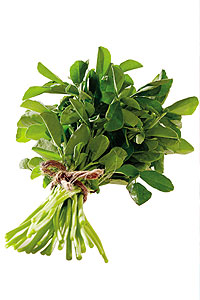Aromatic, fresh or dried, with strong medicinal value, this wonderful culinary flavouring agent called fenugreek (Trigonella foenum-graecum) or menthya (Kannada) is used both as an herb (the leaves) and as a spice (the seed). The name fenugreek comes from Latin for "Greek hay". It is indigenous to the eastern shores of the Mediterranean Sea, but is grown in India, Morocco, Egypt and England as well. The herb, which can grow to be about two feet tall, blooms white flowers in summer. The rhombic yellow to amber coloured fenugreek seed, commonly called Methi, is frequently used in the preparation of pickles, curry powders and pastes, and is often used in the cuisine of the Indian subcontinent. One can bite into the young leaves; sprouts of fenugreek, are eaten as greens, and the fresh or dried leaves are used to flavour other dishes. The dried leaves called kasuri methi have a bitter taste and a strong characteristic smell. In India, powdered fenugreek seeds are mixed with yoghurt and used as a conditioner for hair.
The versatility of fenugreek lies in its use while making khakhra, a type of Indian bread as well as in  injera/taita, a type of bread unique to Ethiopian and Eritrean cuisine. The word for fenugreek in Amharic (Ethiopian language) is abesh, and the seed is often used in Ethiopia as a natural herbal medicine to treat diabetes, just as its powder is used as an antidote to the same disease in India.
injera/taita, a type of bread unique to Ethiopian and Eritrean cuisine. The word for fenugreek in Amharic (Ethiopian language) is abesh, and the seed is often used in Ethiopia as a natural herbal medicine to treat diabetes, just as its powder is used as an antidote to the same disease in India.
This chameleonic ingredient finds itself in various other cuisines of the world. In Turkey, fenugreek is called çemen, a hot paste used in pastirma, a form of meat. The same paste is used in Egypt. The Arabic word hulba for the seed resembles its Mandarin Chinese counterpart hu lu ba. In Yemen, it is the main condiment added to the national dish called saltah. Called ambélilé in Persian, it is one of four herbs used in the Iranian recipe Ghormeh Sabzi, a mixed vegetable curry. In Egypt, fenugreek seeds are prepared and had as tea, by being boiled then sweetened. This is a popular winter drink served in coffee shops.
The sharp odour of fenugreek is one of the reasons why, it has always been a controversial ingredient for many dishes. A side effect of consuming even small amounts of fenugreek (even as an infusion in water) is similar to the stench of maple syrup or curry in the eater's sweat and urine, caused by the potent aroma compound sotolone. It is also used in the production of flavouring for artificial syrups.
Miraculous herb
 The multi-fold benefits of consuming fenugreek have come down the ages. In India it is used as a digestive aid and as a milk producing agent by lactating mothers to increase inadequate breast milk supply. It can be found in capsule form in many health food stores. It’s surprising to note, how fenugreek seeds were shown to lower serum cholesterol and triglycerides in human-beings Several trials have demonstrated the anti-diabetic effects of the seeds on most metabolic symptoms associated with type-1 and type-2 diabetes in both humans and relevant animal models. Fenugreek is currently available commercially in encapsulated forms and is being prescribed as a dietary supplement. Recent research, shows that the multi-faceted fenugreek is known to protect against breast cancers, used in cosmetics when the seeds are soaked, powdered and used to make lip balm and tonic. Medicinally used to make tea, it can reduce fever and relieve menstrual cramps, or as an ointment to treat skin infections. A handful of fenugreek seeds is known to
The multi-fold benefits of consuming fenugreek have come down the ages. In India it is used as a digestive aid and as a milk producing agent by lactating mothers to increase inadequate breast milk supply. It can be found in capsule form in many health food stores. It’s surprising to note, how fenugreek seeds were shown to lower serum cholesterol and triglycerides in human-beings Several trials have demonstrated the anti-diabetic effects of the seeds on most metabolic symptoms associated with type-1 and type-2 diabetes in both humans and relevant animal models. Fenugreek is currently available commercially in encapsulated forms and is being prescribed as a dietary supplement. Recent research, shows that the multi-faceted fenugreek is known to protect against breast cancers, used in cosmetics when the seeds are soaked, powdered and used to make lip balm and tonic. Medicinally used to make tea, it can reduce fever and relieve menstrual cramps, or as an ointment to treat skin infections. A handful of fenugreek seeds is known to
increase libido in men and serves as an aphrodisiac.
Culinary tool
The diversity of the fenugreek spice shows through its kaleidoscopic use in cooking. Fenugreek seeds are ground and roasted to flavour curry and are often used to give a maple flavour to sweets and candies. The leaves are high in iron and used to fortify the nutritional value of salads. It’s strong whiff is the one which wafts through a North Indian Restaurant. The fresh leaves are used as a vegetable and dried, as herbs. This splendid herb is a challenge to every chef and a doctors delight.



 It's Not Greek... It's Fenugreek
It's Not Greek... It's Fenugreek

 injera/taita, a type of bread unique to Ethiopian and Eritrean cuisine. The word for fenugreek in Amharic (Ethiopian language) is abesh, and the seed is often used in Ethiopia as a natural herbal medicine to treat diabetes, just as its powder is used as an antidote to the same disease in India.
injera/taita, a type of bread unique to Ethiopian and Eritrean cuisine. The word for fenugreek in Amharic (Ethiopian language) is abesh, and the seed is often used in Ethiopia as a natural herbal medicine to treat diabetes, just as its powder is used as an antidote to the same disease in India.  The multi-fold benefits of consuming fenugreek have come down the ages. In India it is used as a digestive aid and as a milk producing agent by lactating mothers to increase inadequate breast milk supply. It can be found in capsule form in many health food stores. It’s surprising to note, how fenugreek seeds were shown to lower serum cholesterol and triglycerides in human-beings Several trials have demonstrated the anti-diabetic effects of the seeds on most metabolic symptoms associated with type-1 and type-2 diabetes in both humans and relevant animal models. Fenugreek is currently available commercially in encapsulated forms and is being prescribed as a dietary supplement. Recent research, shows that the multi-faceted fenugreek is known to protect against breast cancers, used in cosmetics when the seeds are soaked, powdered and used to make lip balm and tonic. Medicinally used to make tea, it can reduce fever and relieve menstrual cramps, or as an ointment to treat skin infections. A handful of fenugreek seeds is known to
The multi-fold benefits of consuming fenugreek have come down the ages. In India it is used as a digestive aid and as a milk producing agent by lactating mothers to increase inadequate breast milk supply. It can be found in capsule form in many health food stores. It’s surprising to note, how fenugreek seeds were shown to lower serum cholesterol and triglycerides in human-beings Several trials have demonstrated the anti-diabetic effects of the seeds on most metabolic symptoms associated with type-1 and type-2 diabetes in both humans and relevant animal models. Fenugreek is currently available commercially in encapsulated forms and is being prescribed as a dietary supplement. Recent research, shows that the multi-faceted fenugreek is known to protect against breast cancers, used in cosmetics when the seeds are soaked, powdered and used to make lip balm and tonic. Medicinally used to make tea, it can reduce fever and relieve menstrual cramps, or as an ointment to treat skin infections. A handful of fenugreek seeds is known to